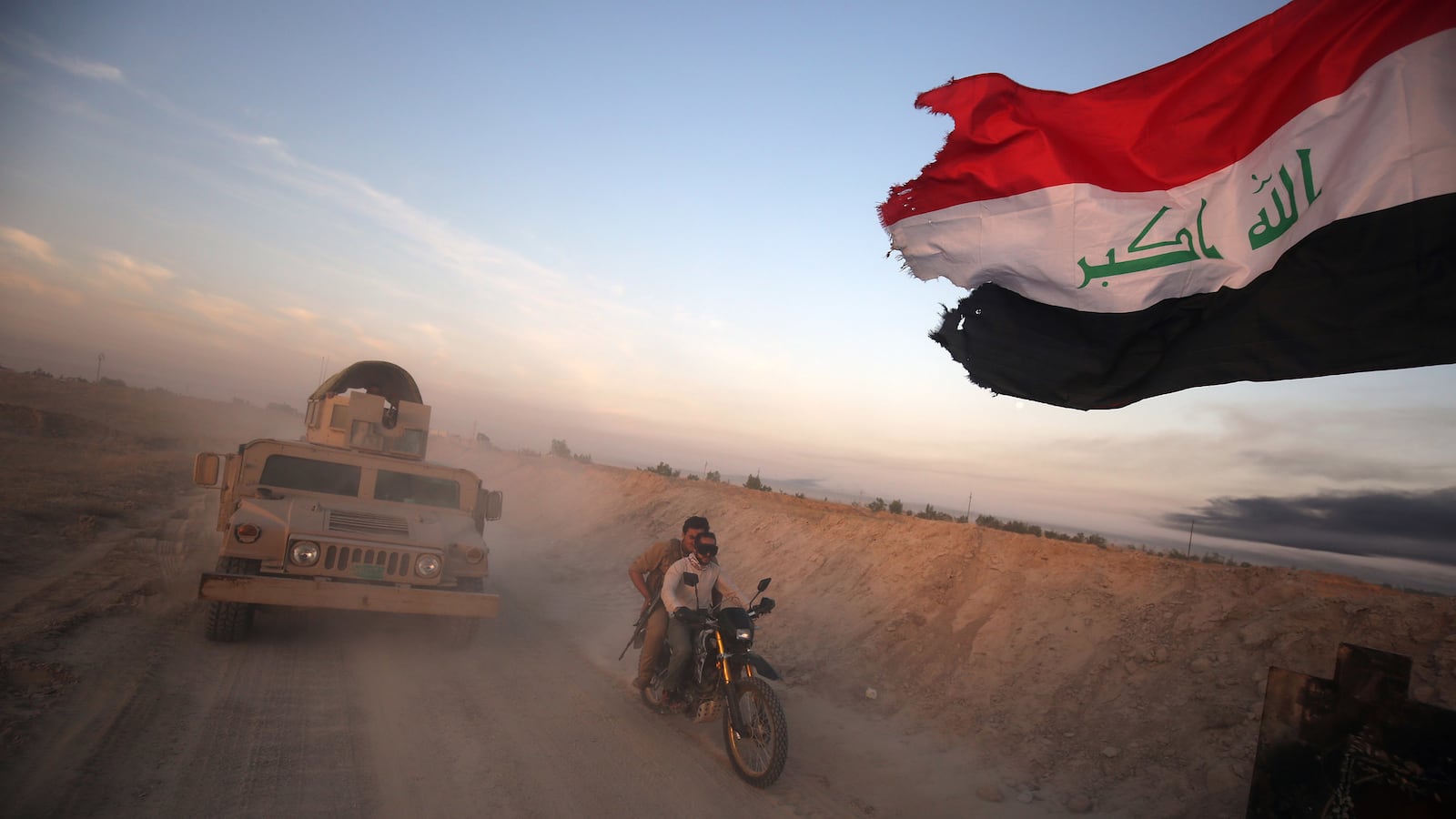For the U.S. military, the battle to rid the Iraqi city of Fallujah of ISIS is shrouded in mystery.
U.S. military officials say the battle for Fallujah could last anywhere from days—once troops enter Fallujah proper—to months, depending on how ISIS responds to the Iraqi offensive and U.S. airstrikes. There is precedent of ISIS both launching counteroffensives and fleeing Iraqi cities coming under threat from the Iraqi security forces.
Some U.S. officials believe the battle for Fallujah could be as ferocious and intense as ISIS’s months-long battle with Kurdish forces for control of the northern Syrian city of Kobani. In other words, while ISIS has generally not stuck around to fight major battles, Fallujah could be the exception. The city is the keystone to the jihadist threat in Iraq today much as it was during the nearly decade-long U.S. war there.
Others see an ISIS too stretched to protect anything other its own capital in Iraq, Mosul.
“Anyone who predicts how long Fallujah will take is wrong,” one defense official explained to the Daily Beast.
But, capturing the uncertainty, a second defense official explained: “It’s probably going to be a long fight.”
So far, ISIS has put up resistance, officials said, as Iraqi security forces seek to take the small towns surrounding Fallujah. On Tuesday, the city of Garma, just east of Fallujah, reportedly fell out of ISIS hands. Iraqi forces now are clearing it of the explosives and booby traps set in place by ISIS as defenses. But by Wednesday, there were reports that Garma was still under ISIS control.
It is hard to make any long term assessments because the Iraqi forces—whoever they they may be—are still not inside the central part of the city. Within Fallujah, residents are receiving conflicting messages. There were reports of leaflets falling urging citizens to leave along humanitarian corridors. There also were reports of ISIS execution squads popping up, threatening as many as 100,000 citizens who try to flee the fighting. Still others believe the supposed safe roads are lined with ISIS explosives.
15 Iraqi forces have been killed so far in the fight—reportedly.
Part of the U.S. military’s uncertainty about how the campaign against ISIS will shape up in Fallujah is that there is no precise comparable battle, despite fact that American forces have fought there over and over again in the last thirteen years. In all, there are an estimated 500 ISIS fighters in Fallujah, the officials said, the same number as there were in the city of Ramadi, which took five months to fall out of ISIS control.
But the force composition for the battle of Fallujah and Ramadi are different in one key way. In Ramadi, the battle did not depend on the militias but rather Iraq’s Special Forces and regular Army, in a block-by-block clearance operation that ended with the all but destruction of the city.
According to U.S. estimates there are as many Iraqi Security Forces as Shiite militia forces around Fallujah or 20,000 in all. In Garma and elsewhere on the periphery of Fallujah, evidence has emerged showing Iranian Revolutionary Guards Corps-backed Shia militia groups participating in the advance against ISIS. These militias include groups previously responsible for killing U.S. soldiers in Iraq—such as the League of the Righteous—and those expressly blacklisted by Washington as foreign terrorist entities, such as the Hezbollah Brigades. Another group spotted in battle is Harakat Hezbollah al-Nujaba, whose secretary general Akram Ka’abi also sanctioned by the US Treasury Department as a terrorist. The Facebook page for that organization recently posted a photograph purporting to show Qassem Soleimani, the commander of the IRGC’s Quds Force, in the “Fallujah operations rooms” along with Abu Mahdi al Muhandis, the leader of the Hezbollah Brigades (and another US-designated terrorist) and Hadi al-Amiri, the head of the Badr Organization, which is another Iranian-backed militia, which yesterday announced its first casualty in the battle.
Phillip Smyth, a specialist on Shia militias at the University of Maryland, told The Daily Beast that these groups have “been using a lot of indirect artillery and rocket fire” against ISIS positions. “You have a new propaganda image from all of circulating on social media every day.” Moreover, the militias have been advancing on Fallujah, Smyth says, since since the summer of 2015. “We’re saying it’s an [Iraqi Security Force] operation when the main forces on the ground for months are the Iranian-backed fighters.”
The U.S. military is not sure whether Shiite dominated military forces now on the outskirts of Fallujah will indeed remain there, as Iraqi officials have suggested, and allow government forces move inside the city. They fear the militias or join the march into the Sunni-dominated city or try to clear it afterwards, potentially stoking sectarian tensions. (There also are Sunni tribal forces that will be part of the battle but U.S. officials could not provide estimates of how many.)
The fall of cities like Tikrit and Ramadi of ISIS control arguably makes Fallujah all the more important for the self-proclaimed Islamic State. It’s the last bastion from which ISIS can threaten the Shiite dominated government in Baghdad, which is just an hour’s drive away. Indeed, Iraqi officials suspect Fallujah was behind the weeklong spate of bombings on the capital, which killed more than 200 people, earlier this month.
In some cities, ISIS has put up relatively little resistance for any enduring period. In the central city of Hit, ISIS forces eventually fled, and the city fell within two months. More recently, the remote western city of Rutbah, Iraq collapsed in a matter of days.
Making U.S. military predictions on the fight for Fallujah even harder is that the of the campaign was something of a surprise for the U.S. military. While Iraqi forces and military forces began surrounding the city roughly two months ago, the decision by Iraqi Prime Minister Haider Abadi to launch an offensive Monday came with only a few days’ notice to the U.S. military, two defense officials told the Daily Beast, even as the U.S.-led coalition is supporting the offensive from the air.
The bombings in Baghdad, U.S. officials said, created a renewed sense of urgency within the Iraqi government. That is far different than the battle of Ramadi, which U.S. officials forecasted months in advance.
Politically, Abadi needs the battleground win as he has, in recent weeks, been confronted with growing protests against the government. Iraqi citizens, including those loyal to rebel cleric Muqtada al Sadr, have stormed the fortified Green Zone, demanding reforms.
The image of Iraqi citizens storming government offices that for the past 13 years have been immune from the chaos that has plagued Iraq punctured the myth that the Green Zone could protect itself from the rest of the country.
It all adds to the sense of uncertainty surrounding the upcoming fight for Fallujah, which perhaps more than any other city has become synonymous with the most difficult days of the U.S. war in Iraq. The U.S. military launched two major offensives in Fallujah to rid it of al Qaeda.
In 2014, Fallujah became the first Iraqi city to fall under ISIS control. That alone makes predicting the battle all but impossible, U.S. officials said.
“We obviously know our way around Fallujah, but we don’t know how this ends,” one of the defense officials explained.
—with additional reporting by Michael Weiss





